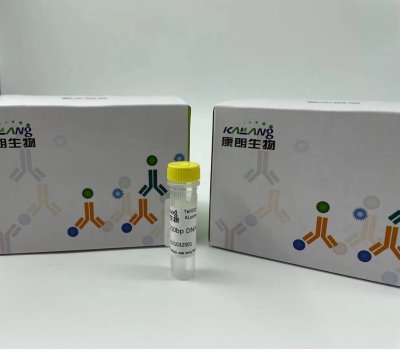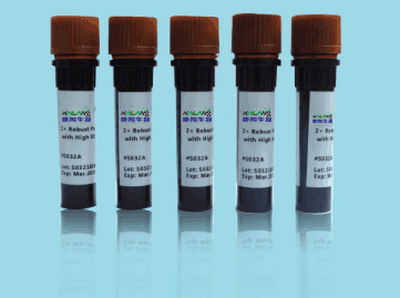QQ:3002763590


客服电话:021-61998208
Anti NUMBL polyclonal antibody
NUMBL抗体
Anti NUMBL polyclonal antibodyNumbl (also known as numblike or Nbl), as a conserved homolog of Drosophila Numb, is specifically expressed in the brain. Numbl is a cytoplasm protein and has redundant functions in embryonic neurogenesis. It plays an important role in ependymal wall integrity and subventricular zone neuroblast survival. However, its expression and function in the central nervous system lesion are still unclear.
Anti HDAC8 polyclonal antibody
HDAC8抗体
Anti HDAC8 polyclonal antibodyHistone deacetylases (HDAC) are a class of enzymes that remove the acetyl groups from the lysine residues leading to the formation of a condensed and transcriptionally silenced chromatin. At least 4 classes of HDAC were identified. As a class I HDAC, HDAC 8 was primarily found in the nucleus. It catalyzes the deacetylation of lysine residues in the histone N-terminal tails and represses transcription in large multiprotein complexes with transcriptional co-repressors. This antibody is a rabbit polyclonal antibody raised against full length HDAC8 of human origin.
Anti Dnmt3a polyclonal antibody
Dnmt3a抗体
Anti Dnmt3a polyclonal antibodyCpG methylation is an epigenetic modification that is important for embryonic development, imprinting, and X-chromosome inactivation. Studies in mice have demonstrated that DNA methylation is required for mammalian development. Dnmt3a is a DNA methyltransferase that is thought to function in de novo methylation, rather than maintenance methylation. The protein localizes to the cytoplasm and nucleus and its expression is developmentally regulated.
Anti S6K polyclonal antibody
S6K抗体
Anti S6K polyclonal antibodyRPS6KB1(Ribosomal protein S6 kinase beta-1) is also named as STK14A, p70 S6KA and belongs to the S6 kinase subfamily. RPS6KB1 is a major substrate of MTOR and acts as a crucial effector of MTOR signaling pathway. It plays a key role in cell growth and proliferation by regulating insulin sensitivity, metabolism, protein synthesis, and cell cycle. RPS6KB1 may play an important role in the progression of HCC and could serve as a potential molecular target for HCC therapy (PMID:22684641). RPS6KB1 is a 70 kDa protein and has 5 isoforms with the calculated molecular mass of 51-59 kDa produced by alternative initiation.
Anti CDK6 polyclonal antibody
CDK6抗体
Anti CDK6 polyclonal antibodyCDK6(Cyclin-dependent kinase 6) is involved in initiation and maintenance of cell cycle exit during cell differentiation and it prevents cell proliferation and regulates negatively cell differentiation, but is required for the proliferation of specific cell types.The molecular weight of CDK6 is 36-40 KDa (PMID: 23563707, 8114739).
Anti PVALB polyclonal antibody
PVALB抗体
Anti PVALB polyclonal antibodyPVALB is a high affinity calcium ion-binding protein that is structurally and functionally similar to calmodulin and troponin C. PVALB is expressed in high levels only in fast-contracting muscles and at lower levels in brain and several endocrine tissues. It is thought to be involved in muscle relaxation.
Anti AKT1 polyclonal antibody
AKT1抗体
Anti AKT1 polyclonal antibodyThe serine-threonine protein kinase AKT1 is catalytically inactive in serum-starved primary and immortalized fibroblasts. AKT1 and the related AKT2 are activated by platelet-derived growth factor. The activation is rapid and specific, and it is abrogated by mutations in the pleckstrin homology domain of AKT1. It was shown that the activation occurs through phosphatidylinositol 3-kinase. In the developing nervous system AKT is a critical mediator of growth factor-induced neuronal survival. Survival factors can suppress apoptosis in a transcription-independent manner by activating the serine/threonine kinase AKT1, which then phosphorylates and inactivates components of the apoptotic machinery.
Anti CD1c polyclonal antibody
CD1c抗体
Anti CD1c polyclonal antibodyThis gene encodes a member of the CD1 family of transmembrane glycoproteins, which are structurally related to the major histocompatibility complex (MHC) proteins and form heterodimers with beta-2-microglobulin. The CD1 proteins mediate the presentation of primarily lipid and glycolipid antigens of self or microbial origin to T cells. The human genome contains five CD1 family genes organized in a cluster on chromosome 1. The CD1 family members are thought to differ in their cellular localization and specificity for particular lipid ligands. The protein encoded by this gene is broadly distributed throughout the endocytic system via a tyrosine-based motif in the cytoplasmic tail. Alternatively spliced transcript variants of this gene have been observed, but their full-length nature is not known. [provided by RefSeq, Jul 2008]
Anti SREBP1 polyclonal antibody
SREBP1抗体
Anti SREBP1 polyclonal antibodySREBF1, also named as BHLHD1 and SREBP1, contains one basic helix-loop-helix (bHLH) domain and belongs to the SREBP family. It is a transcriptional activator required for lipid homeostasis. The SREBPs are synthesized as precursors anchored to endoplasmic reticulum (ER) membranes and complexed with SCAP. When the cellular cholesterol level is low, SREBP-SCAP complexes move to the Golgi apparatus, where SREBPs undergo a two-step proteolytic processing, leading to the release of the mature form, an N-terminal fragment, i.e, basic helix-loop-helix leucine zipper transcription factor. These factors enter the nucleus where they bind to sterol regulatory elements (SRE) in the promoter regions of a number of genes whose products mediate the synthesis of cholesterol and fatty acids. [PMID: 21698267]. This antibody can recognize the 125kd precursor form and the 68kd mature form of human SREBF1.
最新动态
-

Anti-GNGT1 KL20092-001(50ul)
2021-10-11 -

Anti-GNGT1 antibody(50ul) KL20093-001
2021-10-11 -

MUC5AC (PT2058) mouse Monoclonal Antibody
2021-01-06 -

mOrange mouse Monoclonal Antibody(Mix)
2021-01-05
热门标签
- Histone H3 rabbit Polyclonal Antibody Histone H3抗体
- EGFR rabbit Polyclonal Antibody EGFR抗体
- Cy3 Conjugated
- AbFluor™ 555 Conjugated
- AbFluor™ 680 Conjugated
- AbFluor™ 350 Conjugated
- AbFluor™ 647 Conjugated
- AbFluor™ 594 Conjugated
- AbFluor™ 405 Conjugated
- Cy5 Conjugated
- AbFluor™ 488 Conjugated
- Cyclophilin B抗体 Cyclophilin B Monoclonal Antibody(2B10)
- COX IV抗体 COX IV Monoclonal Antibody(6C8)
- PCNA抗体 PCNA Monoclonal Antibody(12D10)
- FAK rabbit Polyclonal Antibody FAK抗体
邮箱:3002763590@qq.com
电话:021-61998208

扫码关注微信公众号















